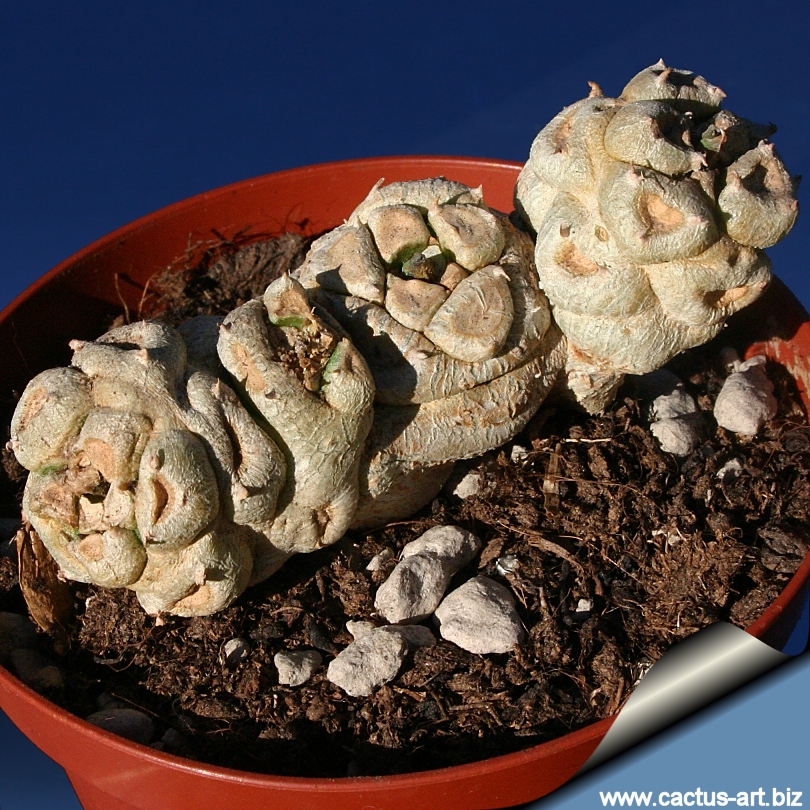|
|
|

Euphorbia poissonii, a juvenile specimen during the winter rest.
This is a choice slow growing species still very rare in cultivation.
|
|
Description: An erect
much-branched shrub 1,2 –> 2 m high, with candelabriform branching with
one to several columns and topped with large green leaves during the
growing season, occasionally sub-spiny,
Stems: Branches cylindrical, succulent, often indistinctly
tessellate, 3-3,5 cm thick silvery-grey, stout.
Spines: Not spiny or sometimes with rudimentary, single spines,
or with spines present only on young plants. So it would appear E.
poissonii can be spineless or have one spine.
Leaves: Leafless or with 5-6 deciduous pale green leaves at the
apex.
Flowers: Short peduncled yellow/green or greenish with red
stamens.
|
|
Cultivation:
Very slow growing and cold sensitive species can to grow in both
pots and in the ground in areas with mild climate,
but they can even be grown indoors. Sun Exposure:
Light shade. They grow well in a very draining mineral potting
substrate. During the summer, they enjoy average feeding and watering.
When dormant, plants are relatively cold tolerant.
Propagation: Usually by
seeds, it can also It be propagated by cuttings; if you remove an
offset, remember to let it dry for a week or so, letting the wound heal
(cutting planted to soon easily rot before they can grow roots). It is
better to wash the cut to remove the latex.
|
|


Advertising
|
|
|
|
|
Family:
Euphorbiaceae
Scientific name:
Euphorbia poissoni
Pax
Place of publication: Bull. Mus. Hist. Nat. Par. 1902,
62.
(frequently misspelled "poissonii"
)
Origin: Tropical West Africa from
Guinea to N Nigeria.
Habitat: Grows on rocks, stony soils; in
open Monotes woodland with grass; on rocky hills (± 400-700 m alt)
in dry savanna. The plant is sometimes cultivated, and often found
in fields and villages in Dahomey
Conservation status: Listed in
CITES appendix 2.
|
|
|
|

Warning: When a plant get damaged it exudes a thick white milky sap
known as latex. This latex (resin) is
poisonous contains some of the most potent irritants known. The
latex is particularly dangerous for the eyes, skin and mucous
membranes. So pay extreme attention not to get any in
your eyes or mouth. Cultivated plants must be handled carefully.
Traditional uses:
-
A piece of the stem is commonly
in Mali mixed with other ingredients in preparing arrow-poison from
the seeds of Strophanthus (Apocynaceae). The latex is a powerful
caustic, and its action seems to be solely as such for it is irritant
to mucous membrances and in direct contact with tissue, but has no
action on the heart, respiration or nervous system.
-
The Jukun of N Nigeria have used
the plant-sap as a potent poison when added to food, drinking-water,
kola nuts, etc.
-
In Sokoto some tribes use the
plant as a fish-poison
|
|